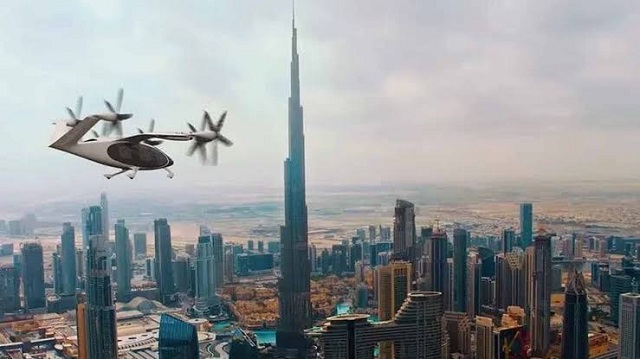
New transportation shows why the city state remains a leader in innovation
Kampala, Uganda | IAN KATUSIIME | Imagine taking a flying taxi from Ntinda to the central business district in Kampala or from town to Entebbe to catch another flight? That is what Dubai, the bustling megalopolis in the United Arab Emirates, is planning to unveil in 2026.
The plan was revealed in a tweet by Sheikh Mohammed bin Rashid Al Maktoum, Vice President, Prime Minister of UAE and Ruler of Dubai ahead of the World Government Summit which took place in Dubai from Feb. 13-15.
The World Government Summit is an annual meeting that deliberates on the future of governance and innovation and the 2023 edition attracted 20 heads of state and over 150 governments including Ugandan vice president Jessica Alupo.
With the flying taxis, Dubai would “become the world’s first city with a fully developed network of vertipots,” according to a video posted by Sheikh Maktoum’s account. The futuristic aircraft operate by vertical take-off and landing and will give their four passengers breathtaking views over Dubai’s ever expanding skyline.
The taxis have a flying range of 241 km and can fly up to 300kph. “The initial launch network of vertipots will connect four main areas of Dubai,” according to the launch video. These are Near Dubai International Airport, Downtown, Palm Jumeirah and Dubai Marina; which are some of the top landmarks and major tourist attractions in the commercial capital of the U.AE.
With trips to Downtown, passengers in the flying taxis can get skyline views of the Burj Khalifa, the world’s tallest building and a prime attraction in Dubai.
The Roads and Transport Authority (RTA) in Dubai has been working with advanced air mobility companies; Skyports Infrastructure and Joby Aviation, to design and develop the infrastructure to have electrical vertical take-off and landing (eVTOL) operations rolled out in 2026. Skyports is a leading provider of infrastructure for the advanced air mobility industry based in the U.K.
Founded in 2018, Skyports Infrastructure “plays a critical role in the Urban Air Mobility ecosystem; designing, building, owning, and operating vertiports that enable eVTOL operators to take off and land in and around cities across the world,” according to its site.
Joby Aviation is a U.S. based transportation company developing an all-electric vertical take-off and landing (eVTOL) aircraft which it intends to operate as part of a fast, quiet, and convenient service in cities around the world.
The pricing for the flying taxis “will be in the range of a limousine service in Dubai, maybe slightly higher,” AP quoted an RTA official Ahmed Bahrozyan. “Another departure from earlier plans include the RTA planning to have piloted flying taxis at first, rather than autonomous ones as previously discussed,” the AP article reported.
The flying taxis will be an addition to Dubai’s ultra-modern transportation network which includes the city’s driverless metro that ferries thousands of the emirates’s residents and visitors. The network includes the dozen lane Sheikh Zayed Road that is a symbol of Dubai’s maddening pace of growth and development.
However Astrid Haas, an urban economist who has written extensively on transportation and cities, sounds a note of caution saying the flying taxis will still face the challenge of any low capacity vehicle. “This could mean simply moving the challenge of congestion from the ground to the air, without promoting any efficiency, sustainability and affordability, like the mass transportation in Hong Kong does,” Haas told The Independent in an email response. She added that its starting rate means it will only be affordable to the elite.
Haas gave the example of Hong Kong which she describes as the city with the most efficient public transport in the world. “You can literally get to any corner of the city with multiple different forms of transportation ranging from a bus, tram, ferry and a metro system just to name a few options,” she said.
She added that its efficiency, affordability and overall effectiveness means that most members of society, irrespective of their income group, use it as their primary mode of transportation as it is even quicker to get around than in a car. “And perhaps even more impressive than that, it is not only affordable for those using it, it is the only public transport system globally that is nearly wholly self-financing, without a national government subsidy,” she explained.
“This is the future for public transport that all governments should aspire to,” she said, “Essentially the complete opposite of investing in a flying taxi – the new, shiny, expensive and low capacity technology that is set to be launched in 2026 in Dubai.”
World Government Summit
The announcement of the flying taxis set the tempo for the World Government Summit, now marking its tenth anniversary. The 2023 summit had the theme ‘Shaping Future Governments’ and its guests included Makhtar Diop, MD of the International Finance Corporation; Klaus Schwab, chairman of the World Economic Forum, Kristalina Georgieva, MD of the International Monetary Fund, actor Idris Elba Tesla Founder and Twitter CEO Elon Musk among others.
President of Turkiye, Recep Erdogan, addressed the summit by video conference and said that the devastating earthquake that hit his country “demonstrated the significance of international solidarity.”
Summit discussions ranged from Artificial Intelligence, vaccine development, the data revolution to capping global warming.
The World Government Summit Organisation is a global, neutral, non-profit organization dedicated to shaping the future of governments. The Summit, in its various activities, explores the agenda of the next generation of governments, focusing on harnessing innovation and technology to solve universal challenges facing humanity.
The organisation has a tool called the WGS Technology Radar which is a study of emerging technologies across multiple fields and sectors, with over 150 technologies being identified, illustrated, described and evaluated. “Each technology represents a future possibility and attempts to estimate when widespread global use might be reached. Decades of scientific discoveries have created a surge in development across multiple sectors, and our relationship with these technologies impacts our everyday lives,” an entry on the Tech Radar reads.
The fields under study include Health, Education, Mobility, Resources, Production and Logistics. Under Education is a section called Memory Editing. It is described as a “method of physically altering the brain in order to erase implant or edit memories.” It can also be used to treat psychological disorders or give people control over their past personal memories. 2055 is the year it is predicted to reach widespread global use.
Under Resources is ‘3D printed Food’ where with additive manufacturing, machines could precisely prepare recipes with different flavours, textures and colours. It is estimated to come int widespread global use by 2035.
Interstellar mining is a not too distant prospect under Logistics: “Optical mining of asteroids and moons could be a new solution to make space exploration missions more feasible and cheap as the technology is a sustainable approach to harvest the very consumables that make space expeditions as expensive as they currently are.” This technology has been predicted for widespread use by 2055.
 The Independent Uganda: You get the Truth we Pay the Price
The Independent Uganda: You get the Truth we Pay the Price


